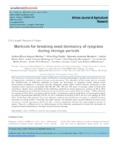Please use this identifier to cite or link to this item:
http://www.alice.cnptia.embrapa.br/alice/handle/doc/1063522Full metadata record
| DC Field | Value | Language |
|---|---|---|
| dc.contributor.author | MARTINS, A. B. N. | pt_BR |
| dc.contributor.author | RADKE, A. K. | pt_BR |
| dc.contributor.author | MONTEIRO, M. A. | pt_BR |
| dc.contributor.author | DIAS, L. W. | pt_BR |
| dc.contributor.author | TUNES, L. V. M. de | pt_BR |
| dc.contributor.author | MENEGHELO, G. E. | pt_BR |
| dc.contributor.author | XAVIER, F. da M. | pt_BR |
| dc.contributor.author | BRUNES, A. P. | pt_BR |
| dc.contributor.author | COSTA, C. J. | pt_BR |
| dc.contributor.author | MITTELMANN, A. | pt_BR |
| dc.date.accessioned | 2017-02-10T11:11:11Z | pt_BR |
| dc.date.available | 2017-02-10T11:11:11Z | pt_BR |
| dc.date.created | 2017-02-10 | pt_BR |
| dc.date.issued | 2016 | pt_BR |
| dc.identifier.citation | African Journal of Agricultural Research, v. 11, n. 45, p. 4567-4570, 2016. | pt_BR |
| dc.identifier.uri | http://www.alice.cnptia.embrapa.br/alice/handle/doc/1063522 | pt_BR |
| dc.description | The presence of dormant seeds makes it difficult to evaluate physiological quality and requires the use of appropriate methods in order to break seed dormancy. The objective of this study was to evaluate the effectiveness of different methods to break the dormancy of ryegrass seeds stored under environment conditions in different periods. Ryegrass seeds, BRS Ponteio cultivar, produced in two locations were used and evaluated after 60, 90, 120, 150 and 180 days of storage under environment conditions. Seeds were submitted to the following methods to break dormancy: sowing at 20 to 30°C without applying any method to break dormancy (control); pre-cooling (5°C) for 3 days + KNO3 followed by sowing at 15 to 25°C; pre-drying (45°C) for 96 h followed by sowing at 20-30°C; immersing the seeds in sodium hypochlorite (NaClO) at 0.5% for 24 h, followed by drying at 45°C for 6 h and sowing at 15 to 25°C. At 60 days after harvest, the most effective method was immersion of seeds in a NaClO solution followed by drying at 45°C. From 90 days after harvest, all methods were equally effective to break seed dormancy, except pre-drying (45°C) for 96 h, which negatively affected the physiological quality of seeds. There is a difference in the effectiveness of the methods employed to break the dormancy of ryegrass seeds depending on the type of post-harvest storage. | pt_BR |
| dc.language.iso | eng | eng |
| dc.rights | openAccess | eng |
| dc.subject | Post-harvest storage | pt_BR |
| dc.subject | Pre-cooling | pt_BR |
| dc.title | Methods for breaking seed dormancy of ryegrass during storage periods. | pt_BR |
| dc.type | Artigo de periódico | pt_BR |
| dc.date.updated | 2017-02-14T11:11:11Z | pt_BR |
| dc.subject.thesagro | Lolium Multiflorum | pt_BR |
| riaa.ainfo.id | 1063522 | pt_BR |
| riaa.ainfo.lastupdate | 2017-02-14 | pt_BR |
| dc.contributor.institution | Andréa Bicca Noguez Martins, UFPEL; Aline Klug Radke, UFPEL; Manoela Andrade Monteiro, UFPEL; Letícia Winke Dias, UFPEL; Lilian Vanusa Madruga de Tunes, UFPEL; Geri Eduardo Meneghelo, UFPEL; Fernanda Da Motta Xavier, UFPEL; André Pich Brunes, UFPEL; CAROLINE JACOME COSTA, CPACT; ANDREA MITTELMANN, CNPGL. | pt_BR |
| Appears in Collections: | Artigo em periódico indexado (CNPGL)  | |
Files in This Item:
| File | Description | Size | Format | |
|---|---|---|---|---|
| Cnpgl2016AfrJAgrResMethods.pdf | 64.11 kB | Adobe PDF |  View/Open |









